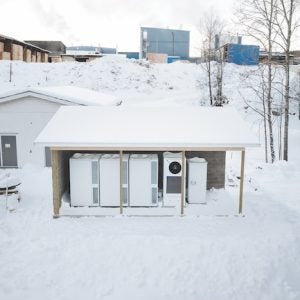London, like most major cities around the world, has experienced extraordinary growth in electricity demand over the last couple of decades, and deregulation has done nothing to ease the problems of distribution system upgrading in an already overcrowded utility infrastructure. If anything, it has resulted in years of delay and under-investment in network development.
Now a major new 400 kV underground XLPE cable infeed link to north-west London is to be installed, for operation in 2004 (Figure 1). It will run from National Grid’s Elstree substation, close to the well known film studios, where three 415 kV lines from the north meet, to the huge London Electricity substation at St John’s Wood (Figures 2) which lies between Lord’s cricket round and the Regents Canal. The route will follow the A5 arterial road almost all the way.
The link is shown schematically in Figure 3. The single circuit link, which is 20 km long, is reckoned to be the highest capacity 400 kV cable ever built with a standard operating rating of 1600 MVA.
The St John’s Wood substation is already undergoing major upgrading following the installation of a large static VAR compensation system in the 1990s (see Modern Power Systems, June 1994, pp 45 – 49 and wall chart). The major demand centres in central London are still supplied via the St John’s Wood and City Road supergrid substations.
No local generation
The relative absence of local generation leads to large power imports on two major double circuit 275 kV cables. Outages on either of these double circuits could lead to steady state voltage instability, or even collapse, resulting in widespread system blackout and supply disruption. The nearest substantial generating plant is probably the 400 MW combined cycle unit at the Enfield Energy Centre in north-east London. The characteristics of the load in London, such as poor power factor, the nature of the critical outages in terms of post-fault reactive power swings and the requirement to maintain post-fault system voltage stability called for urgent introduction of the SVC solution.
It was calculated that two –106/+150 Mvar SVC’s would provide system voltage support following supergrid trippings over a wide geographical area in addition to providing close and continuous voltage control and reactive support for a wide range of system conditions throughout daily and annual load cycles. Figure 4 shows the arrangement of SVCs along with a single line diagram of one compensator. Now that this substation is to receive even larger imports via the new 400 kV XLPE cable, it seems that no new static var capacity will be needed but transformers will be used to change the voltages.
ABB has the $75 million contract to refurbish the St John’s Wood substation, which involves replacing older switchgear with 18 bays of ABB’s new compact 400 kV GIS switchgear (Figure 5). This may eventually be extended to 21 bays if and when a second 400 kV XLPE circuit is added in the new tunnel. ABB also has the contract to refurbish the major City Road substation in central London while the Northfleet substation to the south-east is to be upgraded by VA Tech Peebles. The extensive programme of upgrading along with new XLPE cable link should ensure greatly increased security of supply to support Ofgem’s NETA (new electricity trading arrangements) by 2004.
The cable
ABB Energiekabel in Mannheim will supply the 61 km of 150 mm diameter 400 kV XLPE cable (Figure 6) to be installed in three 20 km lengths in a 3m diameter underground tunnel of almost identical design to those recently completed in Berlin (see MPS March 1999, pp 23-25). Figure 7 shows a cross section of the tunnel topography. Total weight of the cable will be some 2440 tonnes. Long term tests on the cable and terminations at the ITH independent text centre near Mannheim will commence in July 2001 and last for one year. ABB Power T&D Ltd of Stone, Staffordshire, UK is the project manager.
The standard operating average IEC rating for the cable will be 1600 MVA with a current of 2309 A. Depending on the time of year and prior operating conditions, a six hour overload rating of 3700 A may be allowed, and for three minutes following a period of 83 per cent of normal capacity operation, in summer or winter, a current of as high as 17 000 A may be allowed.
This is likely to be the most difficult XLPE cable ever to be manufactured. XLPE cables of higher power capacity and transmission distance have already been used and are building up a wealth of operation experience in such projects as TEPCO’s 500 kV central Tokyo underground transmission network, and the Berlin east-to-west underground cable link. This latter example has two three phase circuits of 400 kV cables rated to carry maximum loadings in excess of 1600 MVA apiece.
ABB’s first commercial application for a 400 kV XLPE cable system was to connect the main unit transformer to the GIS switchgear for the Altbach Deizisau parallel combined cycle power plant near Stuttgart (see MPS, August 1995, pp 31 – 42). The 380 m long cable circuit was installed in a channel with a separate tray for each single core cable. The cable featured a longitudinally and radially water tight design with an 800 mm2 aluminium conductor, a 150 mm2 copper screen, and a laminated sheath made of aluminium foil and high density polyethylene. It entered service in August 1997.
The extrusion of the dielectric is the key process in the manufacture of XLPE insulated cables. The quality of the insulation system including the semi conducting shields is largely dependent on the extrusion parameters and the die design together with the quality and processing of the raw materials for the continuous vulcanisation process.
The copper conductor cross-section of 2500 mm2 for the London Infrastructure cable was determined for continuous load and is of standard round, stranded and compacted design.
The conductor (Figure 6) is covered by the conductor screen, the insulation and the insulation screen. These three layers are extruded simultaneously by means of a triple extruder, thus achieving the smooth surface between insulation and conductor and insulation screens. The next layer consists of conductive tapes that are applied over the insulation screen. The screen consists of copper wires and a counter helix of copper tape covered with swelling powder that forms a longitudinal water barrier when it comes into contact with water.
The cable features a radially water-tight laminated sheath as protection against external influences. The laminated sheath consists of a copolymer-coated aluminium tape fix-bonded to the outer polyethylene sheath. While the PE-sheath provides protection against mechanical damage, the aluminium tape prevents radial penetration of water or water vapour. Additionally, a flame-retardant layer is extruded together with the PE-sheath to protect the cables in case of fire. The three cables will be cross bonded at regular intervals along the length to limit sheath voltage.
The cable to SF6-GIS termination design (Figure 8) and the cable joints, which will comply with IEC 859, will be a further development of the concept so successfully tested in the one year 400 kV prequalification test for XLPE cable systems at CESI (Centro Elettrotecnico Sperimentale Italiano) conducted on behalf of BEWAG and featuring the stringent requirements laid down by Cigre.
These prefabricated, maintenance free, terminators and joints are designed to be routine testable. The sealing end has a capacitative stress control achieved by using a taped stress cone with conductive inserts.
The construction of the joint accessory is now well proven in service. The body of the joint is made from an insulating body of epoxy resin with an integrated electrode, with two lateral stress cones made of silicon rubber.
The high voltage sealing of the cable insulation and the epoxy resin body is achieved by applying pressure through prestressed cones of silicon rubber with integrated stress control. The prestressing is accomplished by the use of spring packets that guarantee equal pressure at all its boundaries for all operating conditions of the cable system.
The now standardised solid joint was tested under IEC 840 conditions with an impulse voltage of 1425 kV and an AC voltage of 2U0 (460 kV). The impulse voltage testing of the cross sheath insulation of the cross-bonding sectionalising joint has been performed according to Cigre recommendations in Electra 128 with 63 kV to earth and 125 kV between the two joint sections.
XLPE cable end seal to GIS terminations are designed along very similar lines to the cable joints at the Altbach parallel combined cycle power near Stuttgart in Germany (Figure 9).
Fibre optic cables will be incorporated into the structure of the cables for temperature sensing and control, and mounted externally for communications purposes. Temperature control in the 3 m diameter tunnel will be achieved by airflow control in the seven ventilator shafts regulated automatically from the fibre optic sensor signals. The variable speed ventilator vans in each of the shafts will be reversible.
The latest designs of cable terminations and joints have integrated sensors which allow partial discharge measurement with sufficient sensitivity to render pre-service testing redundant. The systems are linked to a monitoring system via the fibre optic cables and a coupling device for display and diagnostics.
Cable tunnel
The London tunnel design will be almost the same as Bewag’s East–West Diagonal Link in Berlin, which has a maximum continuous rating of about the same value.
Although it travels through some quite hilly country until it reaches the outskirts of London, the cable tunnel does not vary in level much more than 2 to 3 m over its entire 20 km length. The depth of the tunnel below the surface varies from 6m at Elstree to around 24 m at St John’s Wood (as deep as 42 m at hilly spots between – see Figure 7). Brown & Root has the tunnel consultancy contract.
The tunnels in Berlin were driven using two directional drilling machines with hydroscreen and fluid assisted drift faces and one machine with a pneumatic assisted drift face. Tunnel sections were consolidated by inserting 1.2 m wide prefabricated concrete tubbings behind the tunnelling machine as it proceeded. Six tubbings made one full lining ring with neoprene and swelling tapes fitted between individual tubbings to make them water-tight.
The cables were transported to the 13 m diameter vertical shafts, fed down to the cable tunnels where winches pulled the cable lengths through wall mounted saddles with two pairs of rollers for transport and guidance (see Figure 10) into their final position. The longitudinal saddle spacing is 7.2 m, the vertical distance between the phases is 0.6 m and the vertical deviation of the snaking in the unloaded condition can be up to 0.2 m.
In the London project all of the cable will be fed into the tunnel at the Elstree end down the 10.3 m diameter vertical terminal shaft and drawn into the tunnel along the entire 20 km length in stages.
Low risk
XLPE cable costs have decreased steadily over the last decade, and they seem destined to fall further. At the same time, the performance of XLPE cables has increased remarkably according to independent studies.
Service failure rates of installed XLPE cables have continued to decrease over the years and even the underground cable approach, in which the cost of tunnels and infrastructure can be enormous, is now becoming competitive with overhead transmission lines in many places. Considering the increasing opposition to granting wayleave and planning consent for the increasing amounts of transmission capacity needed to meet growing demand growth in most areas of the world, future potential for XLPE technology would seem to be considerable.






